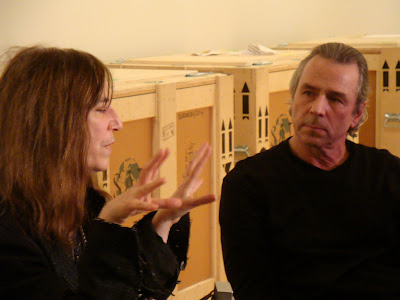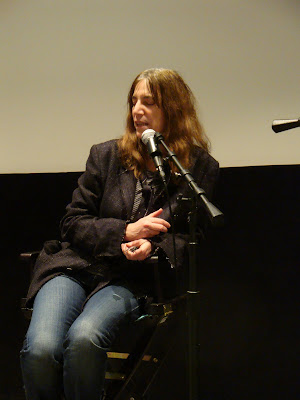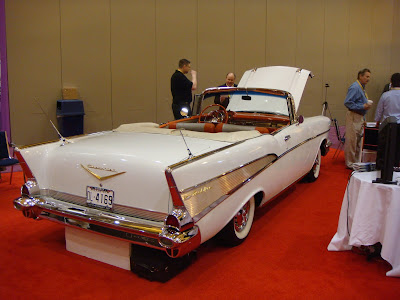
WE HAD AN AMAZING OPPORTUNITY FOR THE FILM FACULTY AND OUR FP FILM CREW TO JOIN PAULA, BARB AND I AT A SPECIAL SCREENING OF THE NEW "PATTI SMITH" FILM - ACTUALLY CALLED "DREAM OF LIFE" AND A CHANCE TO SIT DOWN WITH PATTI AND FILM AN INTERVIEW WITH HER AND STEVEN SEBRING WHO DIRECTED AND SHOT THE FILM OVER A TEN YEAR PERIOD AND THEN SPENT ANOTHER 2 YEARS IN EDIT. AFTER THE INTERVIEW, AMAZINGLY, PATTI HOPPED UP AND DID A SONG FOR US AND LATER, FOLLOWING THE SCREENING AND THE PUBLIC PANEL SECTION OF THE EVENING LED BY JIM DEROGATIS, PATTY DID ANOTHER SONG AND A SPECIAL POEM THAT SHE HAS COMPOSED IN HONOR OF PRESIDENT OBAMA.
Durban International Film Festival
2008 Won Best Documentary
for: Patti Smith: Dream of Life (2008)
Sundance Film Festival
2008 Won Cinematography Award Documentary
for: Patti Smith: Dream of Life (2008)
Nominated Grand Jury Prize Documentary
for: Patti Smith: Dream of Life (2008)



































INTERVIEW WITH DIRECTOR STEVEN SEBRING FROM FILMMAKER MAGAZINE
Since he first picked up a camera, Steven Sebring has been defying expectations and blurring genre boundaries. A South Dakota native who grew up in Arizona, Sebring taught himself photography during his teens and then honed his style during several years spent in Europe. Following his return to the States, the mix of glamor and grit he brought to his images made him an in-demand fashion photographer, and also distinguished himself as an inventive celebrity portraitist. His background in fashion and an interest in cinema led to him direct two synergistic projects for DKNY, New York Stories (2003) and its follow-up Road Stories (2004), short films that showcased Sebring's visual and narrative flair, as well as Karan's couture. Recently, Sebring has also overseen two book projects, Bygone Days (2005), a collection of photographs by his great-great uncle, John Penor, chronicling his life in rural South Dakota, and Lalanne (2006), a tome featuring Sebring's pictures of the work of French artists Claude and François-Xavier Lalanne.
In 1995, Spin magazine commissioned Sebring to shoot a session with Patti Smith, and the instant rapport between photographer and subject inspired Sebring to embark on a documentary about the legendary poetess of punk. Sebring filmed Smith intermittently over the course of 12 years for Patti Smith: Dream of Life, capturing both her high energy live shows and unguarded private moments that reveal the flipside to her onstage persona. Shot on 16mm and mostly in moody black-and-white, Sebring's film adopts an abstract, almost experimental style which is well-suited to capturing Smith's aesthetics. Featuring a wealth of Smith's music as well her poetic narration, Patti Smith: Dream of Life has a lyrical, rhythmic quality and unconventional structure that help it transcend the usual restrictions of the documentary form. Sebring has expanded the scope of his project by creating a tie-in art installation with Smith, Objects of Life, and a book of photographs — also called Patti Smith: Dream of Life — which will be published later this month.
Filmmaker spoke to Sebring about his epic documentary undertaking, the convergence of photography and cinema, and making a film with Picasso and Parker Posey.
Filmmaker: Before the interview started, you were talking about a screening of the film at the Museum of Modern Art, and how you wanted it to play at places like that. Do you view the film simply as a documentary, or as more than that?
Sebring: I don't like it when people call it a documentary. I always say it's a visual poetic experience and Patti Smith is the star. It's my version of how to look at an artist - but again, this movie came out so organically, from the hip, me and Patti. It just became something really unusual.
Filmmaker: Tell me about how your relationship with Patti Smith began. I believe you were doing a photo session with her for Spin magazine in 1995.
Sebring: I used to shoot a lot for Spin magazine, and I'd photographed Michael Stipe just a month before. He and Patti were working together on a song, I think it was called "E-bow the Letter," and Patti had a list of photographers from Spin magazine. She doesn't like to take pictures with too many people and Michael said, "Well, you should work with Stephen Sebring." So it was really through Michael — I adore Michael for that little plug.
Filmmaker: So what happened in that session?
Sebring: There was an immediate connection. I didn't grow up with Patti Smith and didn't know a whole lot about her, and she kinda knew that. I think that's what drew her to me too — I was learning about her, you know? We didn't take a picture until the end of the day, we just kinda hung out. And that's like the movie too: I didn't have a camera the whole time. Every once in a while, I'd travel with her and bring my camera. But we just had a good connection, and then she eventually invited me to Irving Plaza in '96. I saw her [play live], and I was like, "Are you kidding me?! This is the same woman I met in Detroit?" Because the woman I met in Detroit is the woman you see in the bedroom [sequences] in the movie — very innocent and very spiritual, very funny. And then you see her on stage, and it's a whole 'nother person. And that's what blew my mind about her.
Filmmaker: So you started filming in 1996?
Sebring: Yes. The London footage in there where she starts talking about Bob Dylan, that was the first footage. And when she says, "You have to stop filming," that was the tension.
Filmmaker: You said it was very organic in how it came together as a film, but what was the initial idea you had for how the project should be?
Sebring: I always knew it was going to be different, because I never went to film school, I just bought a movie camera and a sound system and experimented. I knew it was going to be an experimental film. I didn't think it would ever be where it is today, I always thought I'd show it in an arthouse where it was free, where it was 16mm projected and cut real raw. It just took its form.
Filmmaker: How often would you film Patti over the decade or so you were making the film?
Sebring: I would usually meet her on tour. Like when she went to Japan, I said, "I'm going to go to Japan," and she wouldn't believe me. And then I'd show up and she'd be like, "Are you kidding me?" That's the way it was. At her mother and father's house in Jersey, it was like "I'm gonna go to my Mom and Dad's house — do you wanna come?" I said, "Yeah, of course!" So it was like that kind of thing throughout the years. It was really like her home movies, in a way. We just had this really cool connection. I was financing [the film], and it was just me, whatever film I could get at the time. Towards the end, I was like, "How shall we make all this footage from all over the world make sense?" And that's when I said, "Let's [shoot] something in your bedroom, in the corner." That was how we made it feel like a stream of consciousness.
Filmmaker: Was there a marked difference between your relationship with Patti when you had a camera and when you didn't?
Sebring: It was always the same. Once in a while, she would perform for the people through my lens. [But] I can quite honestly say that throughout the whole movie, there's nothing forced in that film, it's all really from her heart and my heart, straight up.
Filmmaker: You shot on black-and-white 16mm stock mostly, I think. But there's a shot late on where it changes from black-and-white to color ...
Sebring: I shot on black-and-white and color stock. Yeah, there's that shot where they're walking and I changed it from black-and-white to color. I was doing a lot where I would shoot color, but I would turn it black-and-white just because I felt it worked better in the flow of the film, or the palate seemed better. When I was filming Patti, I would use what I had. I wasn't saying, "I'm going to shoot all this in black-and-white," or "I'm going to shoot all this in color," it was like "What do I have? What should I get more of?" Because nothing was lit in the film — nothing — I had to use a faster film. If she was in a dark space, I would have to use color, faster — and then I'd stop to push the film, like, two stops to see what I'd get. With 16mm, you see the grain and the dark, and there's something beautiful about that. Our logic was to make it have an artistic sense to it, and that's what I do.
Filmmaker: There's a moment when Patti Smith is talking about Bob Dylan and mentions Don't Look Back, which it turns out you hadn't seen. Given that, how aware were you of the territory you were entering by making a music documentary? And did you see Don't Look Back afterwards?
Sebring: Not until two years after that, probably, and then last Christmas Patti bought me the box set. But I really haven't seen anything. The only things I've ever really watched are Kurosawa films — I'm a Kurosawa freak. I love Hitchcock, all those old school directors and films. Touch of Evil. I've never really watched any documentaries. Sometimes I don't want to be influenced that much, or I see something and I'm really disappointed. So I was completely a free bird when it came to making this.
Filmmaker: This film is steeped in music, and is very rhythmic and poetic in its feel.
Sebring: Music is really important to me, and mostly sound. I like subliminal sound. I'm one of those guys who can put some really beautiful sounds or music to something tragic. I love messing with people's minds, that's why I'd always use the sound of a train in the film, because for me it's lonely sadness. Or birds chirping. It's all this chaotic music that she did with Robert Mapplethorpe. I love that and I think it's really important to do stuff like that, so music and sound are very inspiring.
Filmmaker: So, it took you 12 years to complete the film...
Sebring: ...Yeah, somebody was telling me at Sundance that Quentin Tarantino was all over this movie, saying "This is what it's all about: somebody taking 12 years to make a movie!" I was like, "That's great, that's really cool." But I don't think I could do another 12 year project. [laughs]
Filmmaker: When did you know that it was time to stop shooting and go into the editing room?
Sebring: It just felt right. When Patti turned 60, we were all like, "This is a whole new chapter of her life." And she was really ready. PBS called me and asked me what was going on with it, and really gave me a little spark again. I thought, "Hmm, maybe we should do something with it..."
Filmmaker: So you were very relaxed about your plans for the film?
Sebring: Yes, very relaxed. I always had a sense, "What should I do with all this footage?" A lot of people were expecting me to do something with it, obviously. But it was very relaxed, and it was like, "I've got some money, I'm doing well, let's take it to another level." I was budgeted for three months of editing, and it went over a year. [laughs]
Filmmaker: How was the editing process for you?
Sebring: It was a really hard film to [edit] — it was its own beast, this movie. We'd try a scene, and it just wouldn't work! And then the more experimental it got, the better things happened. It was really cool. There was no script and I was just making the script as we went. That's why I found it really refreshing. Plus I didn't have to go through anybody to tell me I can or can't do that. We had control because we owned it. This is our thing. We didn't let anybody in until the end.
Filmmaker: How much footage did you shoot?
Sebring: My editor knows, but I don't know. When you're financing something like this on your own, you don't overshoot. That's how I take pictures. The problem with video is that people just overshoot and don't think about what they're doing, and it's a nightmare in post because you have to sit there and look at it all. Who cares? With this, I would really concentrate on what I was filming to make sure it looked visually perfect, as if I was shooting stills. A lot of the time, my camera would run out [of film], and I didn't have anybody loading my camera so I would just have to stop and I would load up the camera [again]. Pretty much all of [the footage] can be used for something, it wasn't wasteful whatsoever.
Filmmaker: The DKNY shorts you did seem very different from this, as they were narrative and were shot in color using a very different palate.
Sebring: That's my commercial side — I know how to sell product and I know how to build companies up. [DKNY] came to me knowing that I'd been dabbling in film, and I was championing this idea of taking fashion and film [and fusing them] because film wants to be fashion and fashion wants to be film. I really don't believe anybody's merged these two. Donna Karan loves film, and I really think if we'd kept on doing those, she'd have her own sitcom. I really, really do. We did those whole things in like three days — it was crazy stuff. I mean, hardcore. But it was a really good crash course for me and really makes me want to do fiction films. Big time. For me to work with actors and really compose would be a dream. Because that's really what I do when I shoot stills: when I shoot an actor, I'm creating some kind of moment, and to be able to roll film on it is really, for me, just changing the camera.
Filmmaker: What's your biggest extravagance?
Sebring: Buying art, like this Lalanne desk. It's wonderful to buy works of art that you know will never depreciate, but the problem is I'll never sell it, you know what I mean? It's really great to admire artists' work, or do a book of them or do a movie.
Filmmaker: If you had an unlimited budget and could cast whoever you wanted (alive or dead), what film would you make?
Sebring: There's so many people... Picasso. It would be some sort of fiction film with Picasso as the actor. And somebody good opposite him would be... Well, I always wanted to do a film with Parker Posey — she's a friend of ours. I think she's genius. How weird would that be?
Filmmaker: Finally, should actors sing and singers act?
Sebring: Yeah. We just watched West Side Story; it was so amazing to see actors sing. But I don't think that exists anymore, good actors that can sing.
Filmmaker: What do you think about people like Jennifer Lopez and Scarlett Johansson releasing albums then?
Sebring: I don't like to see Jennifer Lopez in movies, I prefer her as a singer. I think you have to be really careful who the actor or singer is to make it believable to me. I think Bob Dylan is a good actor, he's done some good things. He'd be somebody I'd like to do a film with on Patti's level. If he'd let me in. Orson Welles would be somebody I'd like to film. Him and Picasso.




















